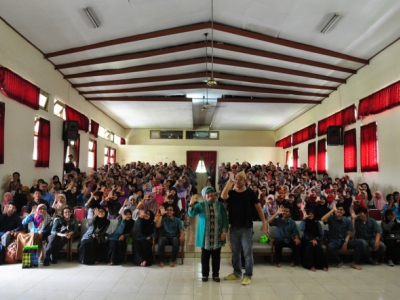EMPOWERING THE CHILDREN ART AND LITERATURE IN INDONESIA

Pop culture has been influencing the children behaviour through electronic media. Consequently, their behavior towards the social environment is also affected. Moreover, they are not able to recognize the values relevant to the existing norms, culture and their age. The daily electronic media surely contribute to the problrm. If filtering system for the contents delivered by the media is not properly applied, the children will not meet cultural and social expectation of their society. This issue has been a great interest for the Student Executive Board of the Faculty of Languages and Arts so that they organised an International Seminat entitled Improving the Role of Arts and Literatures as a Medium of Character Education for Children (17/12/2014) at Karawitan Laboratory supported by the Office of International Affairs and Partnership of YSU.
The strategies to protect the Indonesian children cultural identity were analyzed through the art and literature perspectives. The two are considered as the bases for building their characters (moral/character education). Therefore, the committee invited a panel of speakers to share their expertise on the children art and literature. They are Dr. Katrin Bandel (a German post colonialism literature and philosophy expert), Dik Doang (a Children Art Teaching Activist at Jurang Doang Jakarta), Anandayu Suri Ardini (a children literature activist at Kolong Tangga Community), and M. Bayu Tejo Sampurno (a Graduate School student of Gadjah Mada University and a researcher in painting classes for disabled children).
"The children behavioral confusion is narrated into a teen novel,” said Bandel in her explanation. “It is unique because a teen novel is written by teenager here. Meanwhile, it is usually written by an adult in Germany. “It is interesting because the empirical story of the novel is considered as personal experience of the teenager,” she added. In her remarks, there are only few of scientific studies of moral education in the teen novel. “By conducting research on teenage novel, the children environment can be revealed so that it is beneficial to explore the literature deeper,” she explained.
The second speaker, Dik Doang, presented his art teaching strategy. “Art teaching for children requires various creative games to make the learners enjoy the learning process,” he said. He emphasized the teaching experience in his art teaching community with the motto “education should free the children to develop their creativity”. Therefore, his community produces various great artists—especially painters.
The third speaker, Anandayu, presented her paper entitled Dekonstruksi Konsep Kepahlawanan oleh JK Rowling dalam Dongeng Berjudul The Warlock’s Hairy Heart (The Deconstruction of Heorism Concept in JK Rowling’s The Warlock’s Hairy Heart). She reviewed Derrida’s deconstruction theory which revealed the ideal versus the marginal concepts portrayed by the relationship between The Knight and The Servant. In line with Anandayu, Tejo presented his independent research in painting. “Children have their own uniqueness that can be spontaneously expressed without being restrained by adults’ understanding,” he wrote in his paper. For him, children will express their emotion better through arts, especially if they learn those arts from early age. “Art develops children’s creativity ,” he said.
“It is hoped that through this International Seminar participant will have a better understanding about the children art and literature to provide the character education.” Moreover, this seminar is relevant to the character education promoted by YSU with its “Leading in Character Building” motto. (Rony)

